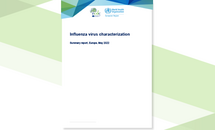Influenza virus characterisation, November 2019
This is the second influenza characterisation report for the 2019–20 influenza season. As of week 48/2019, 6 887 influenza detections across the WHO European Region had been reported; of which 84% were type A viruses, with A(H3N2) prevailing over A(H1N1)pdm09, and 16% type B viruses, with 123 of 137 (90%) ascribed to a lineage B/Victoria.
Executive Summary
Since the October 2019 characterisation report, three shipments of influenza-positive specimens from EU/EEA countries were received at the London WHO Collaborating Centre (CC) - the Francis Crick Worldwide Influenza Centre (WIC). A total of 112 virus specimens, with collection dates after 31 August 2019 to be considered at the February 2020 WHO Influenza vaccine recommendation meeting, were received. HA genetic analyses reported here focus on full-length gene sequences for viruses from around the world with collection dates after 31 August 2019 and available in the Global Initiative on Sharing All Influenza Data (GISAID) as of 4 December 2019.
No A(H1N1)pdm09 test viruses from EU/EEA countries have been characterised antigenically since the last report, but the great majority of viruses from other sources have shown good reactivity with antisera raised against the 2019–20 vaccine virus, A/Brisbane/02/2018. The two viruses with collection dates after 31 August 2019, for which genetic characterisation was completed, fell in the 6B.1A5A subgroup. Globally, based on sequence data available in GISAID, subgroups 6B.1A5A (n = 96), 6B.1A5B (n = 26) and subclade 6B.1A7 (n = 19) viruses were detected recently.
Since the last report, two A(H3N2) viruses were characterised antigenically. Both were clade 3C.3a and antigenically similar to the vaccine virus, A/Kansas/14/2017. Of the 11 viruses characterised genetically, seven were subgroup 3C.2a1b+T131K, two were subgroup 3C.2a1b+T135K-A and two were clade 3C.3a. Globally, based on sequence data available in GISAID, subgroups 3C.2a1b+T131K (n = 175), 3C.2a1b+T135K-B (n = 18), 3C.2a1b+T135K-A (n = 16), clade 3C.3a (n = 10) and subclade 3C.2a2 (n =1) viruses were detected recently.
No B/Victoria-lineage viruses were characterised in this reporting period.
Download








